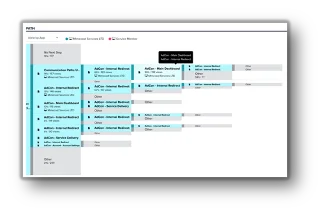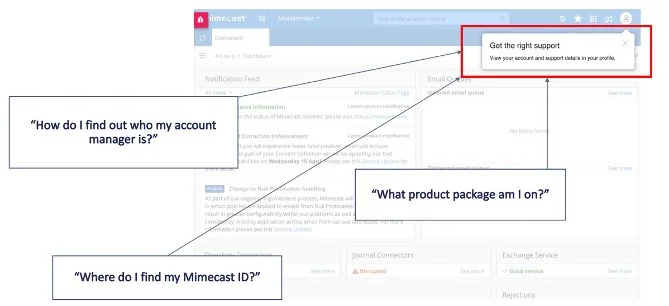
It seems there’s always some new attack vector for cybercriminals to pursue as they look to exploit weaknesses in companies’ systems. Cybersecurity leader Mimecast’s platform works day in and day out to head off any onslaught by securing email systems, protecting data, detecting malicious activity, and training employees to be security-minded.
Damit Kunden jedoch das Potenzial von Mimecast voll ausschöpfen können, müssen sie auf das ständig wachsende Portfolio an Sicherheitsfunktionen der Plattform aufmerksam gemacht werden. Josh Douglas, der VP of Product Management bei Mimecast, und Beatrice Fabris, UX and Content Development Managerin des Unternehmens, nahmen kürzlich an dem Webinar „Datengestütztes Produktwachstum – 3 Wege zum Erfolg“ teil. Darin diskutierten sie, wie sie Produktdaten nutzen, um Entscheidungen zu treffen, neue Ideen zu entwickeln, neue Funktionen zu fördern und ein besseres Produkterlebnis für Kunden zu schaffen.
Mimecast brought Pendo in about two years ago to provide a backbone of product usage analytics to help decrease friction in the product, reduce support tickets, and support upsell and cross-sell initiatives.
Mimecast’s first pass at using Pendo in-app guides to boost customer engagement coincided with the launch of its Threat Dashboard feature, which offered users insight into the malicious activity Mimecast’s anti-virus layer was blocking on their systems. Douglas wanted to ensure users were aware of the feature, and that their first use was a seamless, enjoyable experience.
Um die Nutzer auf die neue Funktion aufmerksam zu machen, erstellte sein Team Pendo-Anleitungen: eine Lightbox-Anleitung, um für die Funktion zu werben, und eine einführende Willkommensanleitung mit einer Videoübersicht für diejenigen, die mit der Lightbox interagierten. Anschließend begleiteten mehrere Tooltip-Anleitungen die Benutzer durch ihren Einstieg. In den ersten fünf Monaten nach dem Start der Sequenz haben sich 35 % der Benutzer damit beschäftigt und 33 % der Mimecast-Kunden haben mit der Nutzung des Dashboards begonnen.


Als nächstes setzte das Team die gleichen Techniken zur Verbesserung des gesamten Onboarding-Prozesses für die Connect-App ein, über die die Nutzer von Mimecast ihre Konten einrichten. Mithilfe der Nutzungsanalysen von Pendo konnte es Probleme in der User Journey ermitteln und dann entsprechende Anleitungen erstellen.
„Wir binden sie bei jedem Schritt ein“, so Douglas. „Haben sie bestimmte Domains, die sie einrichten müssen? Gibt es zusätzliche Maßnahmen, die wir ihnen anraten? Gibt es noch anderes, was Sie außerhalb von Mimecast unternehmen sollten, um mit unseren Produkten erfolgreich zu sein? Wir nehmen etwas von der persönlichen Betreuung aus dem Support-Team und übertragen das direkt auf das Produkt.“
Mithilfe der Anleitungen konnte Mimecast auch sein Verfahren zur Erfassung von Benutzerfeedback verbessern. Mit den Umfragen in der App können die Nutzer ihre Meinung zu verschiedenen Bereichen der Produkte äußern. Gleichzeitig wird so ein zusätzlicher Berührungspunkt für die Bewerbung von Funktionen oder Inhalten geschaffen.
Eine Anleitung, die entwickelt wurde, um Feedback zum API-Programm von Mimecast zu sammeln, erzielte 2.600 Antworten und 462 Kommentare. Eine weitere Anleitung, in dem die Nutzer gefragt wurden, welche ergänzenden Angaben sie gern auf der Registerkarte „Analyse“ des E-Mail-Sicherheitsprodukts des Unternehmens sehen würden, hatte eine noch höhere Beteiligung. 1.000 Nutzer klickten sich durch, um mehr über die Funktion zu erfahren. In beiden Anleitungen waren außerdem Verweise auf weitere Ressourcen zu den jeweiligen Funktionen enthalten.
Dieser Prozess ist laut Douglas bei Mimecast inzwischen Standard. Die daraus gewonnenen Erkenntnisse werden nicht nur zur Verbesserung des Produkts genutzt, sondern auch, um die Vertriebs- und Markteinführungsteams besser zu informieren, so dass sie ausführlichere Beratungsgespräche führen können.
Die Anleitungen waren auch ein wichtiges Instrument zur Steigerung der Cross-Sell- und Upsell-Möglichkeiten auf der Mimecast-Plattform, so Douglas.
A guide distributed to Mimecast’s entire customer base promoting a cybersecurity awareness training led to 28,500 views, 924 click-throughs, and more than 85 demo requests. That translated to thousands of leads to fill seats in the sessions.
Als während der Coronapandemie mit Anleitungen für kostenlose Testversionen einiger Funktionen des Unternehmens geworben wurde, hatten 81 % der Geschäftsabschlüsse für die Funktion Web Security Service und 50 % der Geschäftsabschlüsse für die Funktion Sync and Recover etwas mit Pendo zu tun, so Douglas.
Nach Aussage von Douglas führt die In-App-Werbung mit Pendo im Vergleich zu traditionellen externen Methoden wie E-Mail regelmäßig zu einem „zweistelligen“ Unterschied bei der Kundenaktivität.
Das Tempo, mit dem die Produkt- und Entwicklungsteams von Mimecast neue Funktionen entwickeln, kann so hoch sein, dass der Kundensupport des Unternehmens manchmal Schwierigkeiten hat, die Nutzung dieser Funktionen selbst gründlich zu erlernen. Douglas und Fabris erkannten, dass man die gleichen Techniken, wie sie für die Einarbeitung neuer Benutzer verwendet werden, auch für die schnelle Schulung der Support-Mitarbeiter einsetzen kann.
Also brachte Fabris den Entwicklungsteams bei, wie man Anleitungen in Pendo erstellt, damit sie diese in ihre Releases einbauen und die Support-Teams automatisch auf den neuesten Stand bringen können. „Wir benutzen denselben Ansatz, mit dem wir zu Beginn unsere Kunden unterstützt haben, um nun auch die Support-Teams zu unterstützen“, so Douglas.
Next, Douglas and Fabris worked to proactively reduce the support teams’ overall case volume by using Pendo analytics, paths, and funnels to locate user pain points, then deploying targeted in-app guides to help users get past them.


Bei der Einführung einer neuen Technologie wie Pendo, die voller umfangreicher Möglichkeiten ist, möchten viele gleich aufs Ganze gehen. Doch davor warnt Fabris. Zuerst brauche es eine geeignete Governance-Struktur.
Deshalb entschieden Douglas und Fabris, Pendo zuerst für die wichtigste E-Mail-Sicherheitsanwendung von Mimecast einzusetzen, bevor sie es auf den restlichen Produktkatalog ausweiten.
Fabris richtete auch ein abteilungsübergreifendes Pendo Advocacy Team ein, damit jede Abteilung, die von Pendo profitieren würde, mitreden konnte. Dieses Gremium trifft sich zweiwöchentlich und bewertet die breiteren Kampagnen und Ziele des Unternehmens, damit die Arbeit mit Pendo auch im Sinn der Unternehmensziele passiert. Eine weitere funktionsübergreifende Gruppe, die sich fast täglich trifft, ist für die Festlegung der Inhalte und deren Platz in den Pendo-Anleitungen zuständig.
Um die Nutzungsanfragen für Pendo zu strukturieren, hat Fabris einen funktionsübergreifenden Hauptkalender eingerichtet, damit Anleitungen sinnvoll eingesetzt und nicht zu viele auf einmal angeboten werden. Das Team hat außerdem zielgerichtete Best-Practice-Vorlagen für die Erstellung und die entsprechende Zielgruppenausrichtung der Anleitungen entwickelt, die ihren Ursprung in den Erfolgskennzahlen der Analysen von Pendo haben.
„Pendo ist nicht nur ein Produkt-Tool, sondern etwas, das uns sehr, sehr am Herzen liegt“, so Fabris. „Unsere Kunden, unsere Verkaufsteams und unsere Marketingteams haben davon profitiert. Denn eine gute Kommunikation ist das A und O.“